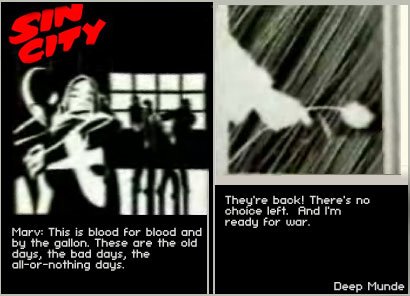Essay Plan
"Does the neo-noir genre continue to follow the representations of the classic film noir genre, with particular reference to ‘Sin City’ (2005)"
Introduction
1) Douglas Pye (1975) - “Generic consistency allows for the shorthand of conventions and stereotypes but also for the interplay between confirmed expectations and novelty
2) Andrew Taylor (1986) - "Genre is what we collectively believe it to be"
3) "Whoever went to the movies with any regularity during 1946 was caught in the midst of Hollywood's profound post war affection fro morbid drama. From January through December deep shadows, clutching hands, exploding revolvers, sadistic villains and heroines tormented with deeply rooted diseases of the mind flashed across the screen in a panting display of psychoneuroses, unsublimated sex and murder most foul" – This article is from a 1947 'Life' magazine within The Cinema Book.
Paragraph 1 – History and Style of Film Noir
1) When did it all begin? Where did it come from?
2) How do these characteristics define Film Noir and how do they represent characters in the film?
Talk about Chiaroscuro lighting (M), Dutch Angle (M), Auteur Theory (G), Patriarchy (I, R)
3) “Back in the post-WWII Hollywood era that spawned most films noir, these movies were called either Crime Thrillers or Murder Dramas” (G) http://www.greencine.com/static/primers/noir.jsp
4) Femme Fetale – “As women during the war period were given newfound independence and better job-earning power in the homeland during the war, they would suffer on the screen in these films of the 40s”
Paragraph 2 – History and Style of Neo Noir
1) Why did Neo Noir emerge?
2) How do these characteristics define Neo Noir and how do they represent characters in the film?
Talk about Chiaroscuro lighting (M), Dutch Angle (M), Auteur Theory (G), Patriarchy (I, R)
3) Although ‘Sin City’ does not have one protagonist the character of Hartigan can be identified as the most idealized version of the classic noir detective, as he is rugged, very manly and saves women time and time again.
Paragraph 3 – The changes in genre
2) Robert Stam identifies four key problems with generic labels in film:
Extension (the narrowness of labels)
Normativism (having preconceived ideas of criteria for genre) [A]
Monolithic definitions (as if an item belonged to only one genre) [G] – the item in this instance is the monochrome/chiaroscuro lighting used for Film Noir and Neo Noir.
Biologism (a kind of essentialism in which genres are seen as evolving through a standardized life cycle) – Zeitgeist; links to how film noir is of it’s time and neo noir is of it’s time [Wider Context – S, E] (Stam 2000, 128-129).
3) “The figure of the femme fetale, a further trend in recent writing on noir has been an attention to issues of masculinity”… “Frank Krutnik, 1991, and for Deborah Thomas, 1992, issues of masculinity and central to Film Noir, which they see as dramatising and exploring ‘a particular crisis in male masculinity’ (R) [1]
Paragraph Four – What hasn’t changed
1) How has Neo Noir adopted the characteristics of Film Noir?
2) The females in film noir were either of two types – dutiful (devoted), reliable, trustworthy and loving women; or femme fatales - mysterious, duplicitous (two faced), double-crossing, gorgeous, unloving, predatory, unreliable, irresponsible, manipulative and desperate women.
http://www.filmsite.org/filmnoir.html
3) Female characters in noir films reinforced Laura Mulvey’s theory on the male gaze and the characters that played the femme fatale held the quality of “to-be-looked-at-ness” [R][I][A] http://www.filmsite.org/filmnoir.html
4) “Heroes (or anti-heroes), corrupt characters and…these protagonists were often morally-ambiguous low-lives from the dark and gloomy underworld of violent crime and corruption.
5) Representation of women. Roland Barthes = Myth. When an ideology is repeated enough, people start to believe it. Sin City has generalized stereotypes such as men being the hero for pretty much every woman in the film.
6) Storylines were often elliptical, non-linear and twisting. Narratives were frequently complex, maze-like and convoluted, and typically told with foreboding background music, flashbacks (or a series of flashbacks), witty, razor-sharp and acerbic dialogue, and/or reflective and confessional, first-person voice-over narration.
http://www.filmsite.org/filmnoir.html
Conclusion – Does Neo Noir follow the same representations as Film Noir?
1) Does Neo-noir follow the representations of Film Noir? If so, why? If not, why?
2) “…Low budgets and B-film status of many film noirs were seen as a priori proof that the films were 'trash” (Cinema Book) [E] http://www.filmsite.org/filmnoir.html
Is this true? Do low budgets account for an entire genre as being labelled ‘trash’?
Reference
[1] Cook, Pam; Bernink, Mieke (2003) Pg 188
Bibliography
Stam, Robert (2000): Film Theory an Introduction. Oxford, UK: Blackwell Publishers
Ltd.F.
Cook, Pam; Bernink, Mieke (2003): The Cinema Book. Stephen Street, London: British Film Institute.

No comments:
Post a Comment